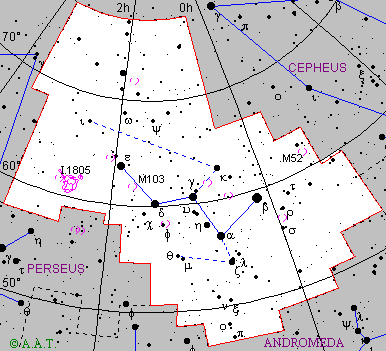 |
 |
| English name | Cassiopeia | ||||
|---|---|---|---|---|---|
| Major stars | alpha Cassiopeiae | Schedar | magn. 2,5 | RA: 00h 40m 30.45s | Dec: +56° 32' 14.5" |
| beta Cassiopeiae | Caph | magn. 2,4 | RA: 00h 09m 10.57s | Dec: +59° 08' 59.4" | |
| gamma Cassiopeiae | magn. 2,8 | RA: 00h 56m 42.51s | Dec: +60° 43' 00.1" | ||
| delta Cassiopeiae | Ruchbah | magn. 2,8 | RA: 01h 25m 48.90s | Dec: +60° 14' 07.0" | |
| epsilon Cassiopeiae | magn. 3,4 | RA: 01h 54m 23.70s | Dec: +63° 40' 12.3" | ||
| Description | Cassiopeia is very easy to recognize thanks to its characteristic W shape: in comparison with Ursa Maior, it is on the opposite side of the Polar Star. Interesting stars are in particular gamma Cassiopeiae and eta Cassiopeiae. The first one unpredictably varies its brightness, fluctuating from magnitude 1,6 to 3,0: these variations are probably due to wraps of gas which go away from the star and intercept its light. The second one is a double star, separable also with small instruments: a component of the system is yellow (magn. 3,5), the other one is reddish (magn. 7,5); they rotate round each other with a 480-year period.
In the constellation of Cassiopeia there are the rests of the supernova observed in 1572 by Tycho Brahe. Appeared near kappa Cassiopeiae, the supernova reached the brightness of Venus and it was visible to the naked eye for sixteen months. Today remain some weak filaments, invisible to the small telescopes. |
||||
| Mythology and history | Cassiopeia, daughter of Arab son of Ermes, was wife of Cepheus, to whom she gave a daughter, Andromeda. She boasted that her daughter was more beautiful than the Nereids, exciting Poseidon's anger. In the sky she is represented as a woman sat in throne. | ||||
 Back to constellations page.
Back to constellations page.